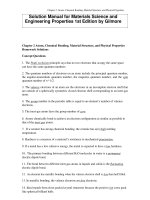download solutions manual for financial reporting for managers a value creation perspective 1st edition by jamie prattu200e d eric hirst
Bạn đang xem bản rút gọn của tài liệu. Xem và tải ngay bản đầy đủ của tài liệu tại đây (319.1 KB, 5 trang )
D.Eric Hirst
Link full download: />APPENDIX A Time Value of Money
TEST YOUR KNOWLEDGE: PRESENT AND FUTURE VALUES
Present values at 8%:
a. Value = $10,000
b. Value = $2,000 Present value factor for an ordinary annuity for i = 8% and n = 8
= $2,000 5.74664 from Table A-5
= $11,493.28
c. Value = $5,000 Present value factor for an annuity due for i = 8% and n = 3
= $5,000 2.78326 from Table A-6
= $13,916.30
d. Value = $3,000 Present value factor for an ordinary annuity for i = 8% and n = 5
= $3,000 3.99271 from Table A-5
= $11,978.13
e. Value = $25,000 Present value factor for i = 8% and n = 7
= $25,000 .58349 from Table A-4
= $14,587.25
f. Value = $3,000 Present value factor for an ordinary annuity for i = 8% and n = 2
= $3,000 1.78326 from Table A-5
= $5,349.78
g. Value = $4,000 Present value factor for an annuity due for i = 8% and n = 3
= $4,000 2.78326 from Table A-6
= $11,133.04
Future values at 8%:
a. Value = $10,000 Future value factor for i = 8% and n = 4
= $10,000 1.36049 from Table A-1
= $13,604.90
b. Value = $2,000 Future value factor for an ordinary annuity for i = 8% and n = 8
= $2,000 10.63663 from Table A-2
= $21,273.26
c. Value = $5,000 Future value factor for an annuity due for i = 8% and n = 3
= $5,000 3.50611 from Table A-3
= $17,530.55
2
d. Value = ($3,000 Future value factor for an ordinary annuity for i = 8% and n = 5) Future
value factor for i = 8% and n = 5
= ($3,000 5.86660 from Table 2) 1.46933 from Table A-1
= $25,859.91
e. Value = $25,000
f. Value = $3,000 Future value factor for an ordinary annuity for i = 8% and n = 2
= $3,000 2.08000 from Table A-2
= $6,240.00
g. Value = $4,000 Future value factor for an annuity due for i = 8% and n = 3
= $4,000 3.50611 from Table A-3
= $14,024.44
Congratulations. You just won the lottery:
Option 1
Present value
=
=
$500,000 Present value factor for an ordinary annuity for i = 10%
and n = 20)
$500,000 8.51356 (from Table A-5)
$4,256,780
Option 2
Present value
=
$4,500,000
Option 3
Present value
=
$1,000,000 + [($2,100,000 Present value factor for an ordinary
annuity for i = 10% and n = 3) Present value factor for i = 10%
and n = 4]
$1,000,000 + [($2,100,000 2.48685 from Table A-5)
.68301 from Table A-4]
$1,000,000 + $3,566,941
$4,566,941
=
=
=
=
Option 3 might be chosen because it has the highest present value. In other words, if receiving the
equivalent amounts for each of the 3 payment patterns, alternative 3 would yield the largest
present value today. Option 2 might be chosen because it doesn’t involve waiting around and you
could blow all your winnings right away.
3
TEST YOUR KNOWLEDGE: IMPLICIT RETURNS (p 382)
1. To determine whether the offer of $110,000 today is a good deal, the future cash flows should
be converted into equivalent values in present dollars (i.e., present values). The contract
specifies two types of future cash flows: $2,000 at the beginning of each year for ten years
and a lump-sum receipt of $300,000 in ten years. The present values of the two types of cash
flows are calculated below.
(a) Present value of annual receipts:
Value = $2,000 Present value factor for an annuity due for i = 10% and n = 10
= $2,000 6.75902 (from Table A-6)
= $13,518.04
(b) Present value of lump-sum receipt:
Value = $300,000 Present value factor for i =10% and n = 10
= $300,000 .38554 (from Table A-4)
= $115,662.00
(c) Total present value:
Value = $13,518.04 + $115,662.00
= $129,180.04
Since the present value of the future cash flows exceeds $110,000, it would not be a good
choice to accept $110,000 in cash today in place of the note. By accepting the cash of
$110,000 now, you would be worse off by more than $19,000.
2. As the discount rate increases, the present value of future cash flows decreases. Since the
present value of the future cash flows discounted at 10% exceeds $110,000, the discount rate
at which you would be a good choice to accept $110,000 in cash instead of the note must be
greater than 10%. Try i = 12%.
Present value = ($2,000 6.32825 from Table A-6) + ($300,000 .32197 from Table A-4)
= $12,656.50 + $96,591.00
= $109,247.50
With a discount rate of 12%, the present value of the future cash flows is slightly less than
$110,000, which implies that you would be better off accepting $110,000 in cash today rather
than accepting the note.
Case and Review Questions: Shoprite Holdings, Ltd.—Revenue Recognition (p 389)
1. Because the terms of the sale provide for interest in the event that full payment is not made
within one year, the difference between present and future value would probably be
immaterial. Recording revenue at the sales price of R2,000 avoids the issue of trying to
predict when the payments are going to be made so that a present value can be calculated.
4
2. Under these circumstances Shoprite would recognize R1427 at the time of sale. This is
based on a 15% interest rate (factor of 2.85498 from table A-6 for 4 periods @15% x R500.
Case and Review Questions: E.ON AG—Asset Retirement Obligations (p 389)
1. The present value of the decommissioning costs at 9% for 20 years would be calculated by
multiplying the factor from table A-4 (0.17843) by €500 million or €89,215,000. This cost
would be added to the €3 billion cash price of the reactor when the asset is recorded,
making the total cost €3,089,215,000.
2. Assuming straight-line depreciation, the balance sheet value of the retirement obligation
would be €66,911,250, 75% (15/20) of the capitalized decommissioning cost.
3. The depreciation recorded each year on the capitalized decommissioning cost would be
€4,460,750, and the annual depreciation on the total cost of the reactor including the cash
price and the decommissioning costs would be €154,460,750. Without the depreciation on
the decommissioning costs the annual depreciation on the reactor would only be a mere
€150 million. If the decommissioning costs had been ignored, there would have been a
failure to spread this cost over the useful life of the asset. Net income for the 20 year life of
the asset would have been overstated.
Case and Review Questions: La Quinta Corporation—Asset Impairment Tests (p 390)
1. The asset is probably not impaired. The criteria for the first step relates to undiscounted
cash flows, not operating profits. The cash flows generated by the property would
approximate the operating profits plus annual depreciation. If the annual depreciation is
$150,000, (5% of book value) annual cash flow would be about $375,000. Over the next
10 years undiscounted cash flows would exceed the book value of the property.
Furthermore, the time period considered in step one would not end after ten years, unless
ten years was the expected useful life of the property. The gross proceeds from sale of the
property would also be taken into consideration in the analysis.
2. Determining the future cash flows from any given asset requires one or more crystal balls
along with expertise in the use of star charts, tarot card interpretation, readings of animal
entrails and other scientifically proven methods of predicting the future.
3. A $325,000 annual return on a $3,000,000 investment would represent a 10.83% rate of
return: $325,000 ÷ $3,000,000 = .1083. Consider however, that the profits are only
indirectly related to the cash flows.
5









